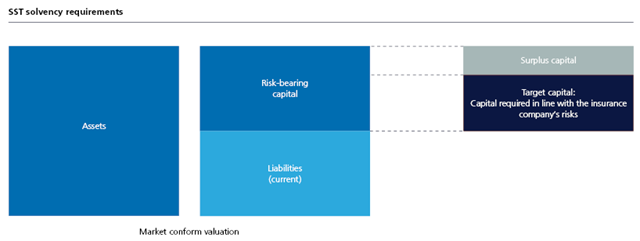Swiss Solvency Test (SST)
The Swiss Solvency Test (SST) is a modern supervisory tool which adopts a risk-based and total balance sheet approach. Insurance companies are required to provide a market conform assessment of the value of their assets and liabilities. Possible changes to these balance sheet positions are then modelled over a one-year period in order to arrive at the total required capital.
Adequate capitalisation
The solvency requirement is met if the available capital (risk-bearing capital) exceeds the required capital (target capital). An insurance company's capitalisation is adequate if it is likely to be able to meet all its obligations to insured persons, even under unfavourable conditions, with an appropriately high probability.
Predefined intervention thresholds
The principles underlying the SST are equivalent to those set out in Solvency II (the corresponding project in the EU). The SST has been in force since 1 January 2011. It has become an indispensable tool for FINMA, allowing it to identify solvency problems in good time and take corrective action on the basis of predefined intervention thresholds. FINMA specialists review the SST reports submitted annually by insurance companies.
The documents listed below are intended primarily for insurance companies, groups and conglomerates which are obliged to perform the SST. They relate to the annual SST report, potential additional reports and reports on internal models.
SST reporting: conceptual basis
Tools
Internal models and results

